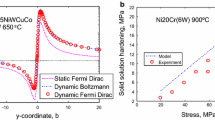Conclusions
-
1.
A significant creep crack growth rate (−10−4−10−5 mm/h) is observed to take place in energy equipment components at values of KI\t~0.1KIc at a temperature of 838 K.
Propagation of the creep crack in the hot zones of steam turbine components may make a significant contribution to the subcritical growth of the crack. With increase in the temperature and the load, the rate of creep crack growth sharply increases.
-
2.
It was established that the diagram of creep crack growth of heat resistant steels over intervals of temperature and loading which correspond to those found in service has three sections.
Transfer from the first section to the second is associated with a change in the failure mechanism, and from the second to the third with a change from failure controlled by the value of KI to that of failure controlled by the value of the modified J*.
Similar content being viewed by others
Literature Cited
A. Ya. Krasovskii and V. A. Vainshtok, “The application of fracture mechanics for estimating the load bearing capability and service life of turbine rotors,” Probl. Prochn., No. 8, 3–10 (1982).
A. Ya. Krasovskii, A. I. Fedosov, V. A. Vainshtok, et al., “Predicting the remaining endurance of housing components made of steel 15Kh1M1FL containing defects,” Probl. Prochn., No. 2, 3–9 (1984).
V. I. Ryzhkov, A. A. Chizhik, L. P. Safonov, and L. A. Bachilo, “The service properties of materials which increase the reliability, economy, and service life of steam turbines,” Énergomashinostroenie, No. 1, 10–16 (1986).
V. I. Gladshtein, “The creep crack growth rate of cast heat resistant steels,” Probl. Prochn., No. 8, 69–73 (1977).
G. A. Tulyakov and V. N. Skorobogatykh, “The endurance of heat resistant components in thermal energy equipment,” Teploenergetika, No. 7, 205 (1987).
V. A. Vainshtok, M. V. Baumshtein, I. A. Makovetskaya, and V. D. Man'ko, “The kinetics and mechanism of creep crack growth in heat resistant steels,” Probl. Prochn., No. 5, 6–10 (1985).
J. D. Landes and J. A. Begley, “A fracture mechanics approach to creep crack growth,” ASTM Spec. Techn. Publ., No. 590, 128–148 (1976).
H. Riedel and J. R. Rice, “Tensile cracks in creeping solids,” ibid., No. 700, 112–130 (1980).
S. Taira and R. Otani, The Theory of High Temperature Strength in Materials [Russian translation], Metallurgiya, Moscow (1986).
L. Zaks, Statistical Evaluation [in Russian], Statistika, Moscow (1976).
Additional information
Institute of Strength Problems, Academy of Sciences of the Ukrainian SSR, Kiev. Translated from Problemy Prochnosti, No. 5, pp. 16–22, May, 1989.
Rights and permissions
About this article
Cite this article
Vainshtok, V.A., Baumshtein, M.V., Makovetskaya, I.A. et al. Relationship of the kinetic diagram of creep crack growth to the failure mechanism of heat-resistant steels. Report 1. Strength Mater 21, 575–581 (1989). https://doi.org/10.1007/BF01528634
Received:
Issue Date:
DOI: https://doi.org/10.1007/BF01528634



